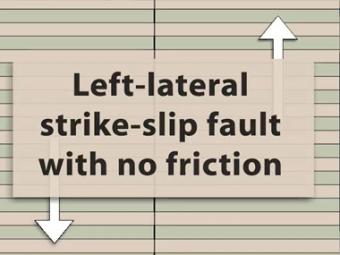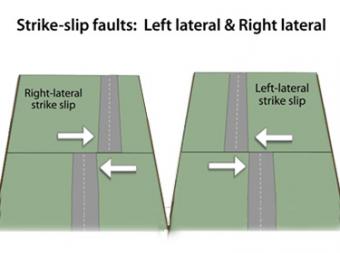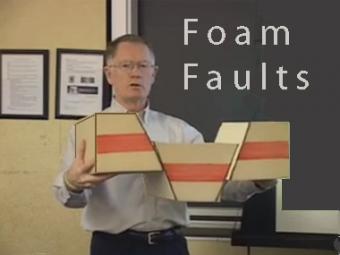
How does rock respond to stress?
[updated 2021] A fault is a rock fracture where the two sides have been displaced relative to each other. Faults are categorized into three general groups based on the sense of slip or movement.
SEE TABS ABOVE for stand-alone versions of each fault type.
This clip includes selected excerpts from the more-in-depth animation, "Earthquake Faults, Plate Boundaries, & Stress"
Normal fault—the block above the inclined fault moves down relative to the block below the fault. This fault motion is caused by extensional forces and results in extension. [Other names: normal-slip fault, tensional fault or gravity fault] Examples include Basin & Range faults.
Reverse fault—the block above the inclined fault moves up relative to the block below the fault. This fault motion is caused by compressional forces and results in shortening. A reverse fault is called a thrust fault if the dip of the fault plane is small. [Other names: reverse-slip fault or compressional fault.] Examples include the Rocky Mountains and the Himalayan Mountains.
Strike-slip fault—movement of blocks along a fault is horizontal and the fault plane is nearly vertical. If the block on the far side of the fault moves to the left, as shown in this animation, the fault is called left-lateral (Figure 2). If it moves to the right, the fault is called right-lateral. The fault motion of a strike-slip fault is caused by shearing forces. [Other names: trans current fault, lateral fault, tear fault or wrench fault.] Examples include the San Andreas Fault, California; Anatolian Fault, Turkey.

[updated 2021] Earth-science educators, do you ever get asked, "What is stress? Why do faults form in Earth’s crust? or How are faults related to plate boundaries?" This animation describes stress in Earth's outer layer and how it leads to both faults and tectonic plate boundaries.

In a normal fault, the block above the fault moves down relative to the block below the fault. This fault motion is caused by extensional forces and results in extension. Other names: normal-slip fault, tensional fault or gravity fault. Examples: Sierra Nevada/Owens Valley; Basin & Range faults.

Cross section of the shallow crust in the Basin & Range. Earthquake produces seismic waves that bump an array of seismic stations. One station records the arrival of the seismic waves on a seismogram.

This left-lateral oblique-slip fault suggests both normal faulting and strike-slip faulting. It is caused by a combination of shearing and tensional forces. Nearly all faults will have some component of both dip-slip (normal or reverse) and strike-slip, so defining a fault as oblique requires both dip and strike components to be measurable and significant.

On this fault, the right-lateral, oblique-slip faulting suggests both thrust faulting and strike-slip faulting. It is caused by a combination of shearing and compressional forces.

In a reverse fault, the block above the fault moves up relative to the block below the fault. This fault motion is caused by compressional forces and results in shortening. A reverse fault is called a thrust fault if the dip of the fault plane is small. Other names: thrust fault, reverse-slip fault or compressional fault]. Examples: Rocky Mountains, Himalayas.

In a strike-slip fault, the movement of blocks along a fault is horizontal. The fault motion of a strike-slip fault is caused by shearing forces. Other names: transcurrent fault, lateral fault, tear fault or wrench fault. Examples: San Andreas Fault, California; Anatolian Fault, Turkey.

Animation shows the buildup of stress along the margin of two stuck plates that are trying to slide past one another. Stress and strain increase along the contact until the friction is overcome and rock breaks.

Left-lateral fault strike slip fault with little or no friction along fault contact. There is no deformation of the rock adjacent to contact. If the block opposite an observer looking across the fault moves to the left, the motion is termed left lateral.

Left-lateral fault strike slip fault with low friction along fault contact. There is no deformation of the rock adjacent to contact. If the block opposite an observer looking across the fault moves to the left, the motion is termed left lateral. Example: the San Andreas Fault of California

The main sense of slip across a strike-slip fault is horizontal. But the movement can be right lateral (ground on opposite side of fault is moving right with respect to the other block) or left lateral (ground opposite moves left). Wallace Creek segment of the San Andreas Fault is example of a right-lateral strike-slip fault.

A transform fault is a type of strike-slip fault wherein the relative horizontal slip is accommodating the movement between two ocean ridges or other tectonic boundaries. They are connected on both ends to other faults.

[updated 2021] Earth-science educators, do you ever get asked, "What is stress? Why do faults form in Earth’s crust? or How are faults related to plate boundaries?" This animation describes stress in Earth's outer layer and how it leads to both faults and tectonic plate boundaries.

How can I demonstrate plate tectonic principles in the classroom?
Video lecture demonstrates the use of foam faults to demonstrate faults, and a deck of cards to demonstrate folds and fabrics in rock layers. Different types of faults include: normal (extensional) faults; reverse or thrust (compressional) faults; and strike-slip (shearing) faults.
We encourage the reuse and dissemination of the material on this site as long as attribution is retained. To this end the material on this site, unless otherwise noted, is offered under Creative Commons Attribution (CC BY 4.0) license